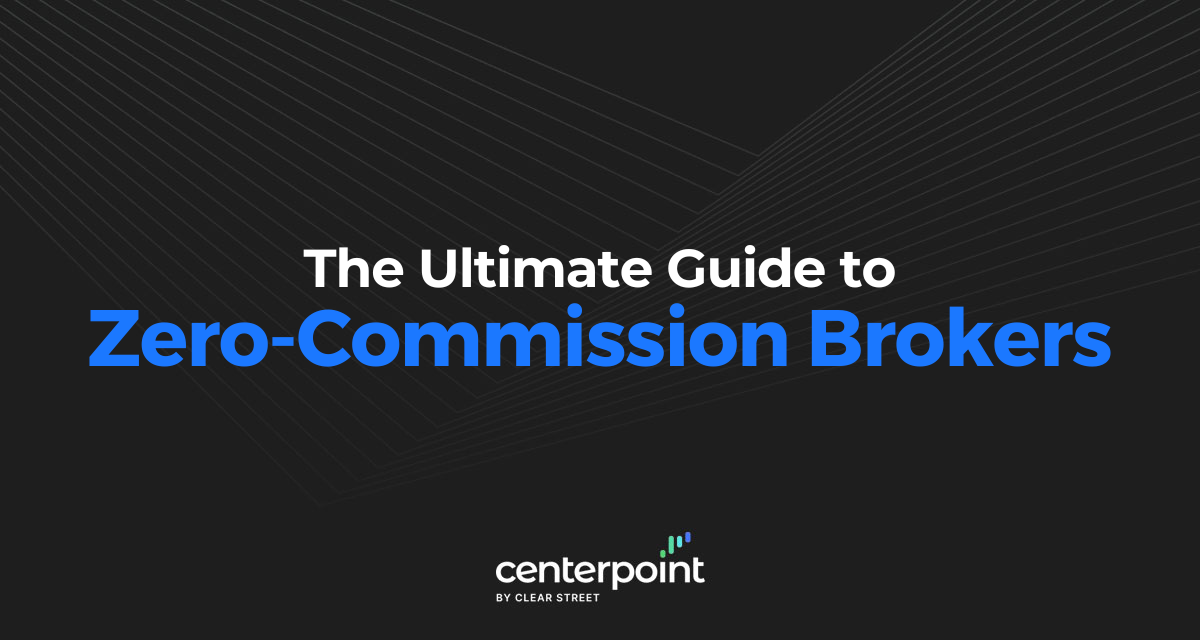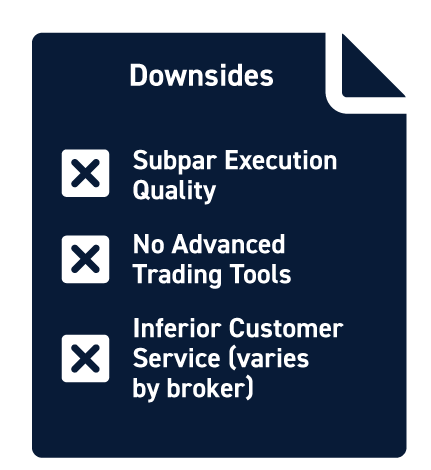Zero-commission brokers have been in the news emphasizing the democratization of investing, pitching cost-savings for clients, and helping fuel the momentum of meme stocks. However, some of these brokers have also received criticism for the gamification of the stock market.
The rise of zero-commission trading was spawned by modern FinTech companies, and eventually spread like wildfire through the rest of the brokerage industry. The idea of commission-free trading sounds too good to be true, and it many cases it may be. It begs the question of how zero commission brokers actually make money.
The Role of a Stock Broker
Everyone needs a middleman known as a licensed stock broker in order to execute trade orders in the U.S. stock market. This may be a traditional stock broker or an online stock brokerage. Regardless, if placing trades on a browser, mobile app, desktop platform, or over the phone, trades can only be executed through a licensed broker/brokerage.
How Stock Brokers Made Money in the Past
In the past, full-service stock brokers made over half their revenues from trading commissions which could run as high as 1% of the total cost of the trade (IE: $100,000 value of stock purchase is $1,000 commission).
Discount brokers came into prominence in the 1990s and 2000s as commissions fell to $19.95 to $4.95 per trade.
Eventually, the rise of the fintech apps sparked the wave of zero-commission trading.
Other Sources of Stock Broker Revenue
As the revenues from commissions continued to dwindle, brokers had to find other sources of income for the brokerage. The more that commission revenues fell, the more urgent it became to find new pipelines to offset sales drops. This created the necessity of three general sources of revenue aside from commissions.
By the time zero-commission trading came into prominence, many discount brokers had already started generating more significant revenue streams. Let’s take a look at a few of the key revenue streams.
Interest
Brokers could find a way to collect interest revenues through many forms. With billions of dollars in client accounts, interest fees can quickly add up, resulting in significant revenue for the broker.
Brokers would collect margin interest when customers purchased shares of stocks on margin. Additionally, they would also collect borrowing fees and interest for stocks they lent out for short sales. Some brokers would offer banking services like loans, interest bearing savings accounts and credit cards.
Premium Services
To bolster the value proposition of commissions, many brokers offered premium services ranging from research to news feeds. Portfolio and wealth management services became a big seller for brokers as they would collect fees as a percentage of your assets in exchange for advice, research, and customized service. These can include estate planning, retirement planning, financial management and eventually low-cost robo-advisors, which operate algorithmically to the masses.
Payment for Order Flow
Many brokers collect fees for directing their customer orders to specific exchanges and third-party liquidity providers. This spawned the growth of zero commission trading as trading apps adopted this as a significant source of revenue. To learn more about payment for order flow, consider reading this guide.
The Introduction of Zero Commission Stock Brokers
Accounting for the other sources of revenue, many brokers weren’t even making the majority of their revenue from commissions. Zero commission went mainstream as mobile application brokers popped up under the guise of democratizing the stock market by providing simple access to young investors. To further entice this demographic, the fintechs offered zero-commission trading, which caught on like wildfire. To prevent losing customers to the fintech apps, some in the discount brokerage industry adopted zero-commission trading as well for a segment of their clientele.
How do Zero Commission Stock Brokers Make Money?
The method behind zero-commission trading is the use of order flow arrangements with third part liquidity providers. Zero-commission brokers would have agreements to direct their customer trade orders to specific providers in exchange for a commission/fee based on volume. The revenues generated through order flow arrangements were significant enough to operate the whole business around this model.
The Benefits of Zero Commission Brokers
The obvious benefit of zero commission brokers is the commission cost savings. Since these brokers cater to the casual investor, their platforms can be simplified to onboard mainstream and beginner investors in a frictionless and nonintimidating manner.
The easy-to-use nature and minimalist interface was less threatening than more complicated trading platforms. This made zero commission brokers ideal for new inexperienced traders who didn’t care or truly understand the risks.
In short, most long-term investors who place a few trades per year will appreciate the simplicity and cost savings brought on by the removal of commission fees.
The Downsides of Zero Commission Brokers
There is a reason why new unsophisticated traders weren’t aware of the downside of zero commission brokers – they were purposely kept in the dark. With order flow arrangements in the background, new investors would assume that the brokerage was looking out for their best interest with zero commissions, unaware of how the commission-free brokers were making their money.
Even with disclosures and SEC filings, most casual investors likely were unaware of the downsides. These are a few of the potential downsides in using zero commission brokers.
Execution Quality
This can be hard to measure even for advanced traders, but the quality of execution on a “free” trade can be poor. Without having any control over order routing, you are leaving your fate in the hands of the broker to decide where your trades will get filled. Order flow arrangements don’t have your best interest at heart since orders are simply sent to the contracted liquidity provider. Your best interests are not the priority within this payment for order flow structure.
While execution quality may not be as noticeable for investors piling into highly-liquid large cap stocks, it is a major consideration for active traders.
Let’s illustrate the concept with an example. Assume you want to buy 1,000 shares of a stock. With a per-share commission rate, you may pay $1-$3 in commissions. With a per-trade commission rate, you may pay $2.95-$6.95. A zero-commission broker will help eliminate the commission fee, saving you between $1-$6.95.
While these savings are nice and simple to understand, they do not account for execution quality. When purchasing 1,000 shares of a stock, a $0.01/share improvement in fill price equates to $10 in “savings.” Purchase 10,000 shares and every $0.01/share improvement equates to $100 in savings. Furthermore, a brokerage that doesn’t prioritize execution quality may be unable to fill an entire order on a highly volatile stock, resulting in a completely missed trade for the trader.
In short, active traders can generally “save” more money by prioritizing execution quality over commission cost savings.
Tools and Resources
Traders want access to the best tools to help them execute their strategies.
As they say, you get what you pay for. Zero commission brokers target casual and beginning traders who likely don’t know what they are missing. These simple platforms may not provide tools like advanced charts, short locates, direct order routing, conditional orders, and research resources.
Customer Service
Customer service at discount brokers and app-based brokers can also be a downside with the lack of phone support, timely response periods, and a general lack of accountability. Zero commission brokers can have their servers overrun when market volatility spikes causing accessibility issues that have resulted in massive losses and missed opportunities. In an effort to minimize costs, many of these brokers only provide e-mail support that can take days to get a response.
On the flipside, day trading brokers know their client-base and understand the urgency of support. For many new traders, customer service is an afterthought until they experience the frustration of waiting for an automated response or even being on hold for 20 minutes during a stressful trade. Active traders appreciate the value of a reliable customer service team that is easily accessible during market hours.
Amateur Traders/Investors May Overtrade
With a lack of training resources and the gamification of these app-based trading platforms, it’s tempting to overtrade. Since commissions are no longer a barrier or consideration, it’s even easier to over trade and tilt when your account is bleeding.
Cost-conscious traders who previously considered the cost of commissions before placing a trade may be susceptible to overtrading when the cost of placing a trade is perceived as “free.”
Should Active Day Traders Use a Zero Commission Broker?
In most cases, the short answer is no. Active day traders need professional tools in the form of advanced charting and indicators, direct order routing choices, real-time scanners, newsfeeds, and lightning-fast executions that they can see. These tools can provide an edge to seasoned traders especially when competing for optimal trade executions and short-sale borrows.
Zero commission brokers are designed for investors and casual traders, not for serious traders. They may be a good gateway to get your feet wet, but brokers who cater to active traders are the ultimate destination for traders that want to evolve. For serious traders who approach their trading as a business, the commission savings should be negligible compared to downsides. Commission costs can also be cut down through volume discounts and pass-through rebates from various ECN and ATS designations. A huge consideration is that improved fills can add more to your bottom line than potential commission cost savings. The bottom line rings true in that you get what you pay for.












